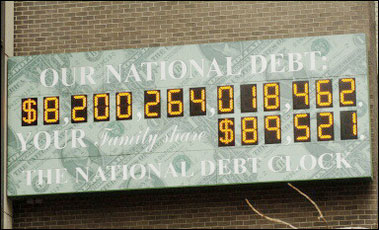NEW YORK - Tick, 20,000 dollars, tock, another 20,000 dollars.
So rapid is the rise of the US national debt, that the last four digits of a
giant digital signboard counting the moving total near New York's Times Square
move in seemingly random increments as they struggle to keep pace.
The national debt clock, as it is known, is a big clock. A spot-check last
week showed a readout of 8.3 trillion -- or more precisely 8,310,200,545,702 --
dollars ... and counting.
But it's not big enough.

The national debt
clock in New York, shows the total US government debt (top) and the
calculated amount per family. The clock does not have enough digits to
show the debt when it reaches the ten trillion dollar mark, which is
expected in the next couple of years.
[AFP] |
Sometime in the next two years, the
total amount of US government borrowing is going to break through the
10-trillion-dollar mark and, lacking space for the extra digit such a figure
would require, the clock is in danger of running itself into obsolescence.
The clock's owner, real estate developer Douglas Durst, knew such a problem
could arise but hadn't counted on it so soon.
"We really expected it to be quite some time," Durst told AFP. "But now, with
the pace of debt growth only increasing, we're looking at maybe two years and
certainly before President (George W.) Bush leaves office in 2009."
The clock was the invention of Durst's father, Seymour Durst, who nursed a
keen sense of fiscal responsibility and believed government profligacy to be a
national curse.
The elder Durst, who died in 1995, originally thought of the idea in the
early 1980s as the US budget deficit started to mount during the presidency of
Ronald Reagan, but the technology was not immediately available to realise his
vision.
The original 11 foot by 26 foot (3.3 meter by 8.9 meter) clock was eventually
erected a block from Manhattan's Times Square in 1989 when the national debt
stood at 2.7 trillion.
For the next decade it tracked, odometer style, the government's red ink with
an extra feature which, by dividing the main figure by the number of families in
the country, offered an estimate for how much each family owed as their share.
Toward the close of the millennium, with a booming economy fuelling annual
budget surpluses, the clock began to slow and finally ran into its first
mechanical problem.
"It wasn't designed to run backwards," Douglas Durst explained.
Believing that the signboard had served its purpose, the Dursts pulled the
plug in 2000 with the debt total showing around 5.7 trillion dollars and the
individual "family share" standing at close to 74,000 dollars.
The clock was covered with a red, white and blue curtain, but not dismantled.
"We'll have it ready in case things start turning around, which I'm sure they
will," Durst said at the time.
He only had to wait two years as the Bush presidency coincided with an
upsurge in borrowing. The curtain was raised in 2002 and the digital readout
flickered back to life showing a national debt of 6.1 trillion dollars with the
numerals whizzing round faster than ever.
In 2004, the old clock was torn down and replaced with a newer model which
had optimistically been modified to run backwards should such a happy necessity
arise.
Instead the debt continued to rise at such a rate that the once unthinkable
total of 10 trillion dollars veered from alarmist fantasy into the realm of
impending reality.
"When it became clear what was going to happen, our first thought was to free
up the digital square occupied by the dollar sign so that we could cope with a
14th digit," Durst said.
The latest plan is for yet another replacement, involving a larger scale
signboard.
"We're not happy at the impact we're making with this one," he said.
Durst insists that the clock is non-partisan in its effort to shame the
federal government over what he sees as its willingness to gamble away the
nation's future.
"We're a family business," Durst said. "We think generationally, and we don't
want to see the next generation crippled by this burden," he said.
Last week, the "family share" readout on the clock stood some loose change
short of 90,000 dollars.